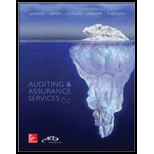
a)
Compute the upper limit on misstatements for 5 percent level of incorrect acceptance and identify the relationship noticed between the risk of incorrect acceptance and the upper limit on misstatements.
a)
Explanation of Solution
Tainting percentage: Tainting percentage is the amount that indicates the proportion by which a “logical unit is misstated” and it is ascertained by dividing the difference among the “recorded balance and the audited value by the recorded balance”.
Formula for calculating tainting percentage is as below:
Upper limit on misstatements: An upper limit misstatement (ULM) is the figure of three components namely, “the projected misstatement, the incremental allowance for sampling risk and the basic allowance for sampling risk “or it is the amount having
The steps involved with calculating the upper limit on misstatements are as follows:
- Initially for calculating the “upper limit on misstatements”, projected misstatements must be calculated by finding out the difference between the “audited value” of an item and recorded balance an item.
- Second, “basic allowance for sampling risk” must be computed by multiplying the sampling interval and confidence factor.
- Finally, “incremental allowance for sampling risk” is computed by multiplying the “projected misstatement” and “incremental confidence factor”.
All of the misstatements must be considered in the upper limit on misstatements computation.
Calculate the upper limit on misstatements.
Step 1: Calculate the tainting percentage.
| Account |
Recorded Amount (a) |
Audited value (b) |
Misstatement |
Tainting Percentage | ||
| X-21 | $3,000 | $1,200 | $1,800 | 0.60 | ||
| Z-24 | $550 | $440 | $110 | 0.20 | ||
| AA-02 | $6,000 | $1,500 | $4,500 | 0.75 |
Table (1)
Step 2: Calculate the projected misstatement.
| Account | Tainting Percentage | Sampling interval | Projected misstatement | ||
| X-21 | 0.60 | × | $10,000 | = | $6,000 |
| Z-24 | 0.20 | × | $10,000 | = | $2,000 |
| AA-02 | 0.75 | × | $10,000 | = | $7,500 |
| $15,500 |
Table (2)
Step 3: Calculate the incremental allowance.
| Account | Projected Misstatement |
Incremental factor minus 1 (Refer to table 4) | Incremental Allowance | ||
| X-21 | $7,500 | × | = | $5,625 | |
| Z-24 | $6,000 | × | = | $3,300 | |
| AA-02 | $2,000 | × | = | $920 | |
| $9,845 |
Table (3)
Note: “For every projected misstatement, whose recorded balance is smaller than the sampling interval, rank the projected misstatements in descending order depending upon the dollar amount”.
Step 4: Calculate the basic allowance for sampling risk.
Note: Confidence factor (3.00) is selected for 0 overstatement misstatements as these sampling intervals do not contain an overstatement error.
Working note (1): Identify the Confidence Factors for Sample Evaluation:
| Number of overstatement misstatements | Risk of incorrect acceptance is 5% |
| 0 | 3.00 |
| 1 | 4.75 |
| 2 | 6.30 |
| 3 | 7.76 |
Table (4)
Note: Refer to exhibit GA.2.
Step 5: Calculate the upper limit on misstatements.
| Particulars | Amount |
| Projected misstatement | $15,500 |
| Incremental allowance for sampling risk | $9,845 |
| Basic allowance for sampling risk | $30,000 |
| Upper limit on misstatements | $55,345 |
Table (5)
Therefore, upper limit on misstatements is $55,345.
b)
Compute the upper limit on misstatements for 10 percent level of incorrect acceptance and identify the relationship noticed between the risk of incorrect acceptance and the upper limit on misstatements.
b)
Explanation of Solution
Calculate the upper limit on misstatements.
Step 1: Calculate the incremental allowance.
| Account | Projected Misstatement |
Incremental factor minus 1 (Refer to table 7) | Incremental Allowance | ||
| X-21 | $7,500 | × | = | $4,350 | |
| Z-24 | $6,000 | × | = | $2,640 | |
| AA-02 | $2,000 | × | = | $720 | |
| $7,710 |
Table (6)
Note: “For every projected misstatement, whose recorded balance is smaller than the sampling interval, rank the projected misstatements in descending order depending upon the dollar amount”.
Step 2: Calculate the basic allowance for sampling risk.
Note: Confidence factor (2.31) is selected for 0 overstatement misstatements as these sampling intervals do not contain an overstatement error.
Working note (2): Identify the Confidence Factors for Sample Evaluation:
| Number of overstatement misstatements | Risk of incorrect acceptance is 10% |
| 0 | 2.31 |
| 1 | 3.89 |
| 2 | 5.33 |
| 3 | 6.69 |
Table (7)
Note: Refer to exhibit GA.2.
Step 3: Calculate the upper limit on misstatements.
| Particulars | Amount |
| Projected misstatement | $15,500 |
| Incremental allowance for sampling risk | $7,710 |
| Basic allowance for sampling risk | $23,100 |
| Upper limit on misstatements | $46,310 |
Table (8)
Therefore, upper limit on misstatements is $46,310.
Want to see more full solutions like this?
Chapter G Solutions
Auditing & Assurance Services with ACL Software Student CD-ROM

 AccountingAccountingISBN:9781337272094Author:WARREN, Carl S., Reeve, James M., Duchac, Jonathan E.Publisher:Cengage Learning,
AccountingAccountingISBN:9781337272094Author:WARREN, Carl S., Reeve, James M., Duchac, Jonathan E.Publisher:Cengage Learning, Accounting Information SystemsAccountingISBN:9781337619202Author:Hall, James A.Publisher:Cengage Learning,
Accounting Information SystemsAccountingISBN:9781337619202Author:Hall, James A.Publisher:Cengage Learning, Horngren's Cost Accounting: A Managerial Emphasis...AccountingISBN:9780134475585Author:Srikant M. Datar, Madhav V. RajanPublisher:PEARSON
Horngren's Cost Accounting: A Managerial Emphasis...AccountingISBN:9780134475585Author:Srikant M. Datar, Madhav V. RajanPublisher:PEARSON Intermediate AccountingAccountingISBN:9781259722660Author:J. David Spiceland, Mark W. Nelson, Wayne M ThomasPublisher:McGraw-Hill Education
Intermediate AccountingAccountingISBN:9781259722660Author:J. David Spiceland, Mark W. Nelson, Wayne M ThomasPublisher:McGraw-Hill Education Financial and Managerial AccountingAccountingISBN:9781259726705Author:John J Wild, Ken W. Shaw, Barbara Chiappetta Fundamental Accounting PrinciplesPublisher:McGraw-Hill Education
Financial and Managerial AccountingAccountingISBN:9781259726705Author:John J Wild, Ken W. Shaw, Barbara Chiappetta Fundamental Accounting PrinciplesPublisher:McGraw-Hill Education





